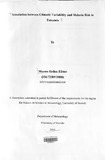| dc.description.abstract | Malaria is still a major public health problem in the United Republic of Tanzania, is the
leading cause of outpatient and inpatient health service attendance and the leading cause of
death in both children and adults.
This study examines the relationship between climate variability and malaria cases in some
selected areas in Tanzania. This was realized through studying the trends, correlation analysis
and modeling of the rainfall, maximum and minimum temperature and laboratory confirmed
malaria cases time series. Data from four mainland sentinel hospitals and total malaria cases
from Zanzibar Island were used to investigate this link, Climate data comprised monthly
minimum and maximum temperatures and monthly rainfall for the period of 1978-2008,
while laboratory confirmed malaria cases were for the period between 2000 and 2008 from
hospitals near the meteorological stations. The epidemic alert threshold for each month was
determined as the average monthly malaria cases in the over five (5) years plus two times the
standard deviation.
The results revealed a non linear relationship exists between climatic variability and malaria
cases in most hospitals i.e. Dareda, Rubya, Mpwapwa, Utete and Zanzibar. Furthermore the
result showed that at extreme conditions' such as higher amounts of rainfall, higher or
temperatures affect malaria transmissions, However studies show that weather extremes may
trigger epidemics outbreaks in particular areas, higher temperatures in combination with
favorable patterns of rainfall and surface water, will prolong transmission seasons in some
endemic locations. The result-also pointed out weather phenomena such as La Nina and El
Nino affects the mosquito population hence malaria transmissions.
Furthermore, when the Malaria epidemic transfer modelj when simulated using a rainfall
threshold of 150 mmJ month of rain for highland areas poor results were obtained in some
areas. A higher threshold of 300 mmJ month of rain When used in Zanzibar produced better
result. However when climatic data were standardized and modeled better results was
obtained as compared to the assigned threshold.
The study was done in only four sentinel hospitals out of 21 sentinel center, extension of the
study for the remaining center is recommended. Lack of long term malaria data is the major
challenge in investigating the impact of climate variability hence climate change this need to
be addressed.
The association observed between malaria cases and the climate variability is crucial for the
health sector in Tanzania and other sectors that are affected directly or indirectly by weather
variables. More studies need to be done so as to improve on the tools that have been
established. | en |

